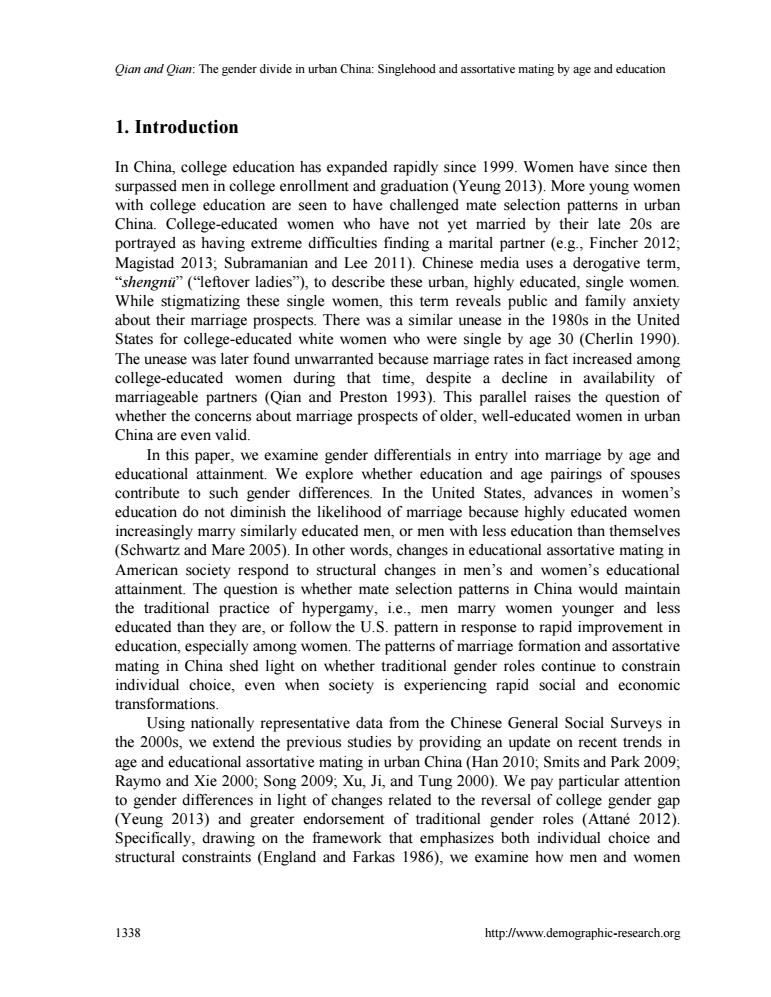正在加载图片...

Qian and Oian:The gender divide in urban China:Singlehood and assortative mating by age and education 1.Introduction In China,college education has expanded rapidly since 1999.Women have since then surpassed men in college enrollment and graduation (Yeung 2013).More young women with college education are seen to have challenged mate selection patterns in urban China.College-educated women who have not yet married by their late 20s are portrayed as having extreme difficulties finding a marital partner(e.g,Fincher 2012; Magistad 2013;Subramanian and Lee 2011).Chinese media uses a derogative term, "shengnu"("leftover ladies"),to describe these urban,highly educated,single women. While stigmatizing these single women,this term reveals public and family anxiety about their marriage prospects.There was a similar unease in the 1980s in the United States for college-educated white women who were single by age 30(Cherlin 1990). The unease was later found unwarranted because marriage rates in fact increased among college-educated women during that time,despite a decline in availability of marriageable partners (Qian and Preston 1993).This parallel raises the question of whether the concerns about marriage prospects of older,well-educated women in urban China are even valid. In this paper,we examine gender differentials in entry into marriage by age and educational attainment.We explore whether education and age pairings of spouses contribute to such gender differences.In the United States,advances in women's education do not diminish the likelihood of marriage because highly educated women increasingly marry similarly educated men,or men with less education than themselves (Schwartz and Mare 2005).In other words,changes in educational assortative mating in American society respond to structural changes in men's and women's educational attainment.The question is whether mate selection patterns in China would maintain the traditional practice of hypergamy,i.e.,men marry women younger and less educated than they are,or follow the U.S.pattern in response to rapid improvement in education,especially among women.The patterns of marriage formation and assortative mating in China shed light on whether traditional gender roles continue to constrain individual choice,even when society is experiencing rapid social and economic transformations. Using nationally representative data from the Chinese General Social Surveys in the 2000s,we extend the previous studies by providing an update on recent trends in age and educational assortative mating in urban China(Han 2010;Smits and Park 2009; Raymo and Xie 2000;Song 2009;Xu,Ji,and Tung 2000).We pay particular attention to gender differences in light of changes related to the reversal of college gender gap (Yeung 2013)and greater endorsement of traditional gender roles (Attane 2012). Specifically,drawing on the framework that emphasizes both individual choice and structural constraints (England and Farkas 1986),we examine how men and women 1338 http://www.demographic-research.orgQian and Qian: The gender divide in urban China: Singlehood and assortative mating by age and education 1338 http://www.demographic-research.org 1. Introduction In China, college education has expanded rapidly since 1999. Women have since then surpassed men in college enrollment and graduation (Yeung 2013). More young women with college education are seen to have challenged mate selection patterns in urban China. College-educated women who have not yet married by their late 20s are portrayed as having extreme difficulties finding a marital partner (e.g., Fincher 2012; Magistad 2013; Subramanian and Lee 2011). Chinese media uses a derogative term, “shengnü” (“leftover ladies”), to describe these urban, highly educated, single women. While stigmatizing these single women, this term reveals public and family anxiety about their marriage prospects. There was a similar unease in the 1980s in the United States for college-educated white women who were single by age 30 (Cherlin 1990). The unease was later found unwarranted because marriage rates in fact increased among college-educated women during that time, despite a decline in availability of marriageable partners (Qian and Preston 1993). This parallel raises the question of whether the concerns about marriage prospects of older, well-educated women in urban China are even valid. In this paper, we examine gender differentials in entry into marriage by age and educational attainment. We explore whether education and age pairings of spouses contribute to such gender differences. In the United States, advances in women‟s education do not diminish the likelihood of marriage because highly educated women increasingly marry similarly educated men, or men with less education than themselves (Schwartz and Mare 2005). In other words, changes in educational assortative mating in American society respond to structural changes in men‟s and women‟s educational attainment. The question is whether mate selection patterns in China would maintain the traditional practice of hypergamy, i.e., men marry women younger and less educated than they are, or follow the U.S. pattern in response to rapid improvement in education, especially among women. The patterns of marriage formation and assortative mating in China shed light on whether traditional gender roles continue to constrain individual choice, even when society is experiencing rapid social and economic transformations. Using nationally representative data from the Chinese General Social Surveys in the 2000s, we extend the previous studies by providing an update on recent trends in age and educational assortative mating in urban China (Han 2010; Smits and Park 2009; Raymo and Xie 2000; Song 2009; Xu, Ji, and Tung 2000). We pay particular attention to gender differences in light of changes related to the reversal of college gender gap (Yeung 2013) and greater endorsement of traditional gender roles (Attané 2012). Specifically, drawing on the framework that emphasizes both individual choice and structural constraints (England and Farkas 1986), we examine how men and women